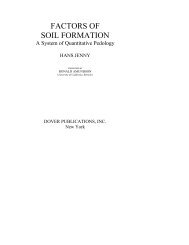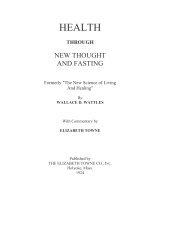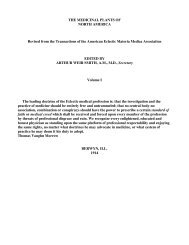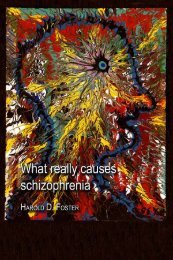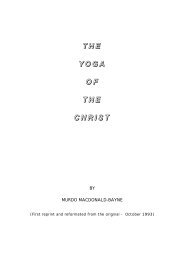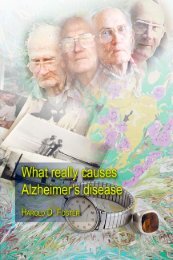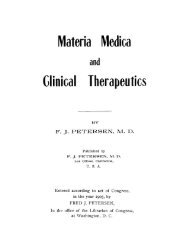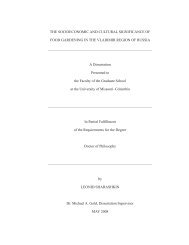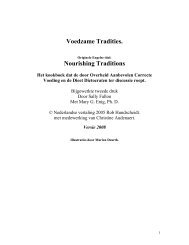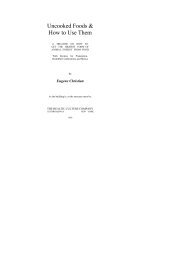historical and scientific perspectives on the health of canada's first ...
historical and scientific perspectives on the health of canada's first ...
historical and scientific perspectives on the health of canada's first ...
Create successful ePaper yourself
Turn your PDF publications into a flip-book with our unique Google optimized e-Paper software.
organized efforts by <strong>the</strong> Métis including petiti<strong>on</strong>s, a Royal Commissi<strong>on</strong> was established in 1934<br />
to examine <strong>the</strong> problems <strong>of</strong> <strong>health</strong>, educati<strong>on</strong> <str<strong>on</strong>g>and</str<strong>on</strong>g> general welfare <strong>of</strong> <strong>the</strong> “half-breed” populati<strong>on</strong><br />
in <strong>the</strong> province. This commissi<strong>on</strong> came to be called <strong>the</strong> Ewing Commissi<strong>on</strong> after its chair. It<br />
included a medical doctor, E.A. Braithwaite, who had played a key role in organizing public<br />
<strong>health</strong> services in Alberta. Evidence presented by <strong>the</strong> recently established Métis Associati<strong>on</strong> <strong>of</strong><br />
Alberta presented testim<strong>on</strong>ials verifying serious levels <strong>of</strong> infectious diseases from six doctors<br />
<str<strong>on</strong>g>and</str<strong>on</strong>g> Indian agents in <strong>the</strong> Grouard area, where it was believed <strong>the</strong> worst <strong>health</strong> c<strong>on</strong>diti<strong>on</strong>s existed.<br />
The reliability <strong>of</strong> <strong>the</strong>se testim<strong>on</strong>ies was challenged by <strong>the</strong> Alberta government in <strong>the</strong> pers<strong>on</strong> <strong>of</strong><br />
Harold Orr, a physician employed by <strong>the</strong> Alberta Department <strong>of</strong> Health. Earlier, Orr had<br />
alerted his minister to <strong>the</strong> political implicati<strong>on</strong>s <strong>of</strong> increased <strong>health</strong> expenditures <strong>on</strong> <strong>the</strong> Métis.<br />
When <strong>the</strong> Ewing Commissi<strong>on</strong> report was issued, it ran to <strong>on</strong>ly fifteen pages, <str<strong>on</strong>g>and</str<strong>on</strong>g> it did agree that<br />
<strong>the</strong> Métis were experiencing serious <strong>health</strong> problems <str<strong>on</strong>g>and</str<strong>on</strong>g> identified a number <strong>of</strong> possible reas<strong>on</strong>s.<br />
They noted that many Métis lived far from any <strong>health</strong> pr<strong>of</strong>essi<strong>on</strong>als <str<strong>on</strong>g>and</str<strong>on</strong>g> lacked m<strong>on</strong>ey both to<br />
cover travel costs to c<strong>on</strong>sult <strong>the</strong>m <str<strong>on</strong>g>and</str<strong>on</strong>g> to pay for medical services rendered. Traveling doctors<br />
<str<strong>on</strong>g>and</str<strong>on</strong>g> nurses, who comm<strong>on</strong>ly visited “Indian reserves”, rarely came to <strong>the</strong>se Métis communities.<br />
The report also noted <strong>the</strong> poor sanitary c<strong>on</strong>diti<strong>on</strong>s which characterized Metis homes <str<strong>on</strong>g>and</str<strong>on</strong>g> <strong>the</strong> lack<br />
<strong>of</strong> proper food (implying in fact that some Metis were, in effect, periodically starving). However,<br />
in <strong>the</strong> final analysis <strong>the</strong> commissi<strong>on</strong>ers wrote, “On <strong>the</strong> whole, <strong>the</strong> Commissi<strong>on</strong> is <strong>of</strong> <strong>the</strong> opini<strong>on</strong><br />
that while <strong>the</strong> <strong>health</strong> situati<strong>on</strong> is serious, it is not, except as to <strong>the</strong> particular diseases menti<strong>on</strong>ed<br />
[presumably tuberculosis <str<strong>on</strong>g>and</str<strong>on</strong>g> venereal diseases], more serious than am<strong>on</strong>g <strong>the</strong> white settlers”.<br />
Clearly, <strong>the</strong> Métis were <strong>on</strong>ce again victimized by <strong>the</strong>ir unclear legal status. The Ewing<br />
Commissi<strong>on</strong> did make it clear that any assistance provided to <strong>the</strong>m was to be given out <strong>of</strong><br />
“c<strong>on</strong>siderati<strong>on</strong>s <strong>of</strong> humanity <str<strong>on</strong>g>and</str<strong>on</strong>g> justice,” <str<strong>on</strong>g>and</str<strong>on</strong>g> not because <strong>the</strong> Métis held any special rights as an<br />
Aboriginal people. The Commissi<strong>on</strong> did not want <strong>the</strong> Métis to become wards <strong>of</strong> <strong>the</strong> state.<br />
However, itt did recommend that l<str<strong>on</strong>g>and</str<strong>on</strong>g> be set aside for <strong>the</strong> Metis, parcels which were referred to<br />
<strong>the</strong>n as “col<strong>on</strong>ies” <str<strong>on</strong>g>and</str<strong>on</strong>g> today as “settlements,” where small hospitals could be c<strong>on</strong>structed.<br />
These col<strong>on</strong>ies were established <strong>the</strong>reafter under <strong>the</strong> authority <strong>of</strong> <strong>the</strong> Métis Populati<strong>on</strong><br />
Betterment Act <strong>of</strong> 1938. The Métis living in <strong>the</strong>se col<strong>on</strong>ies were to be periodically provided with<br />
<strong>the</strong> services <strong>of</strong> a traveling physician, with <strong>the</strong> anticipati<strong>on</strong> that ultimately a resident physician<br />
would be hired. It remains unclear whe<strong>the</strong>r or to what extent <strong>the</strong> Métis were to be required to pay<br />
for <strong>the</strong>se services.<br />
While <strong>the</strong> systematic treatment <strong>of</strong> tuberculosis am<strong>on</strong>g First Nati<strong>on</strong> people <strong>on</strong> reserves had begun<br />
in western Canada until 1935, <strong>the</strong> Métis did not receive similar attenti<strong>on</strong> until later, primarily in<br />
<strong>the</strong> 1940s, which coincided with <strong>the</strong> establishment <strong>of</strong> <strong>the</strong> “col<strong>on</strong>ies.” Between 1934 <str<strong>on</strong>g>and</str<strong>on</strong>g> 1939,<br />
Métis represented <strong>on</strong>ly 6.9 per cent <strong>of</strong> <strong>the</strong> patients discharged from general tuberculosis<br />
treatment facilities in <strong>the</strong> province, but this figure began to rise <strong>the</strong>reafter, until by <strong>the</strong> outset <strong>of</strong><br />
<strong>the</strong> 1960s <strong>the</strong> Métis c<strong>on</strong>stituted nearly <strong>on</strong>e quarter <strong>of</strong> <strong>the</strong> patient load. This obviously indicates<br />
that a much higher proporti<strong>on</strong> <strong>of</strong> <strong>the</strong>ir populati<strong>on</strong> was c<strong>on</strong>tracting tuberculosis, than that <strong>of</strong> <strong>the</strong><br />
mainstream. The prevalence <strong>of</strong> disease remained high am<strong>on</strong>g <strong>the</strong> Métis for many years, despite<br />
<strong>the</strong>se <strong>health</strong> programs. Again unlike <strong>the</strong> First Nati<strong>on</strong>s <str<strong>on</strong>g>and</str<strong>on</strong>g> later <strong>the</strong> Inuit, who received regular<br />
programs <strong>of</strong> diagnosis <str<strong>on</strong>g>and</str<strong>on</strong>g> treatment, <strong>the</strong> Métis were subjected to <strong>on</strong>ly 'irregular' screening.<br />
Interestingly, a notable study issued in 1963 claimed that <strong>the</strong> Métis tuberculosis rate was, by <strong>the</strong><br />
early 1960s, about half that <strong>of</strong> <strong>the</strong> “treaty Indians”. It was argued that, “<strong>the</strong> major determinants<br />
20




